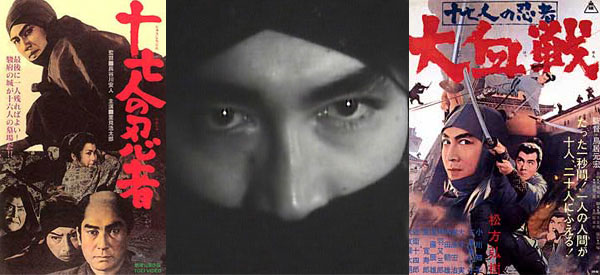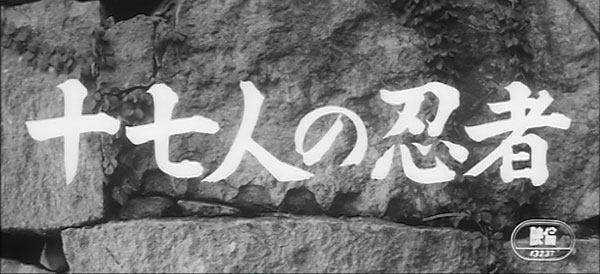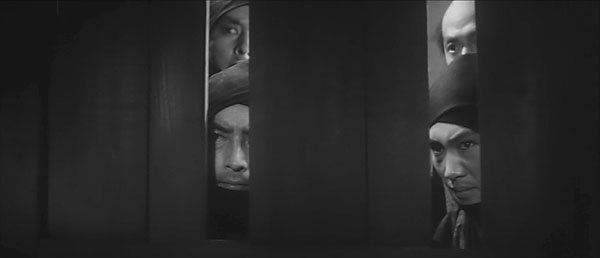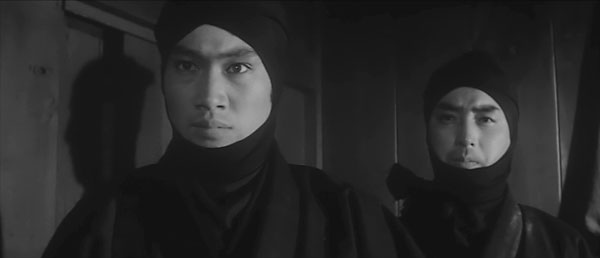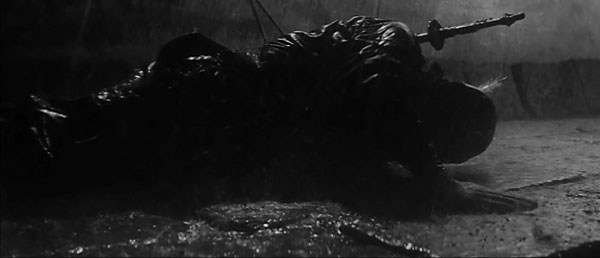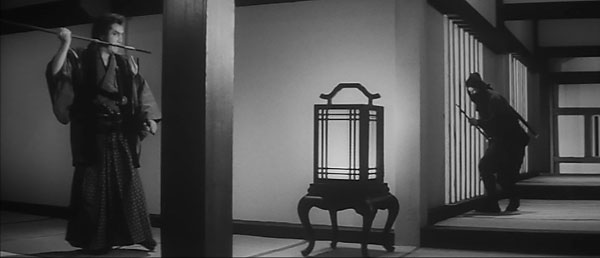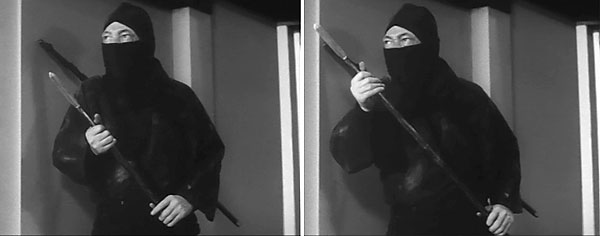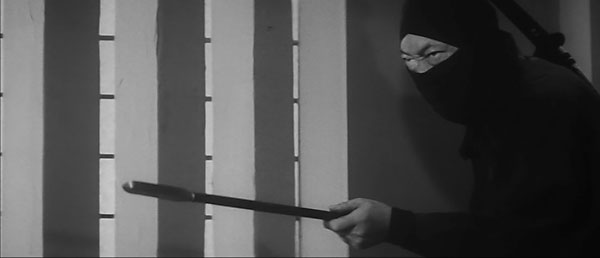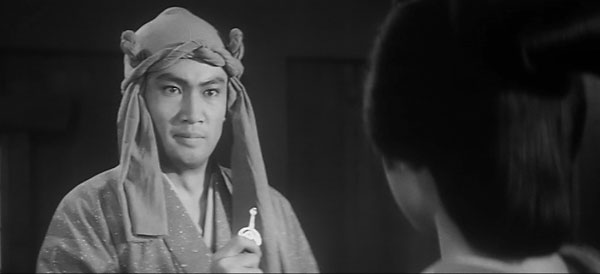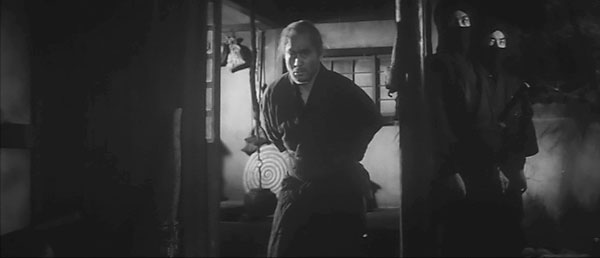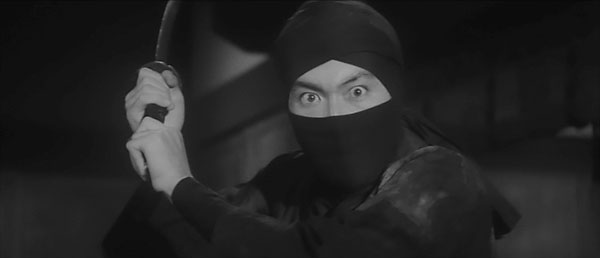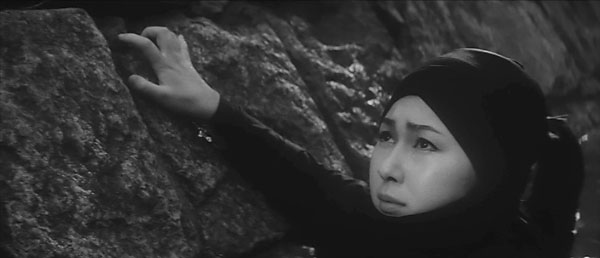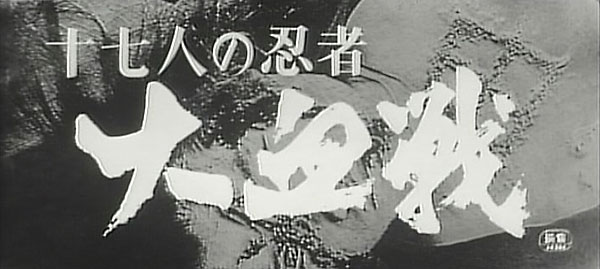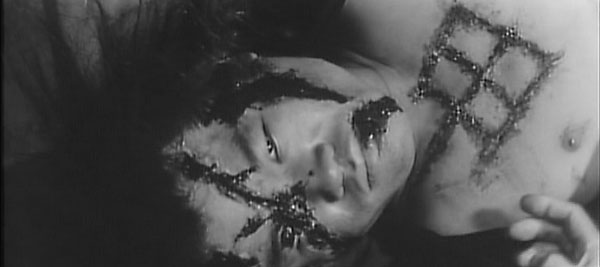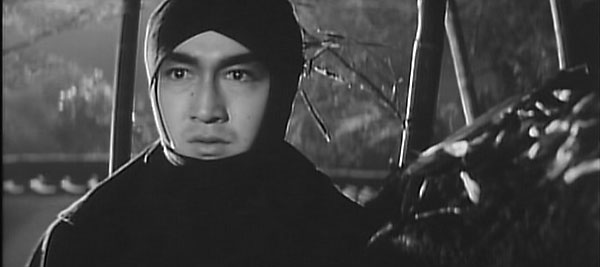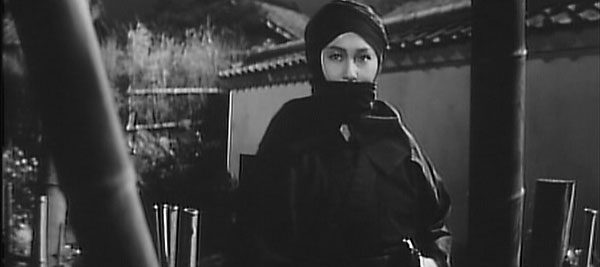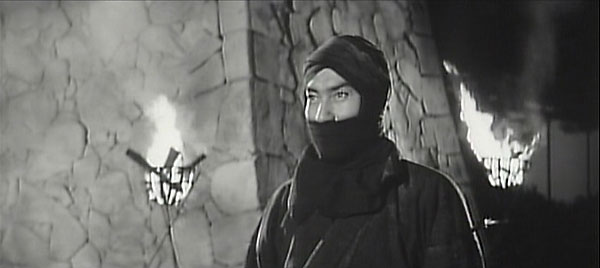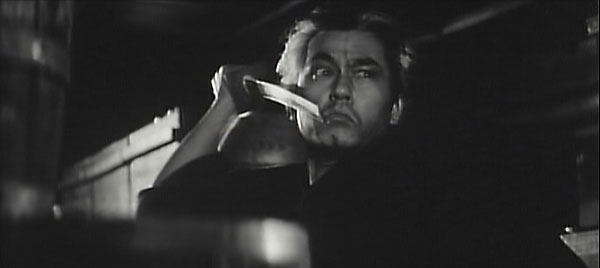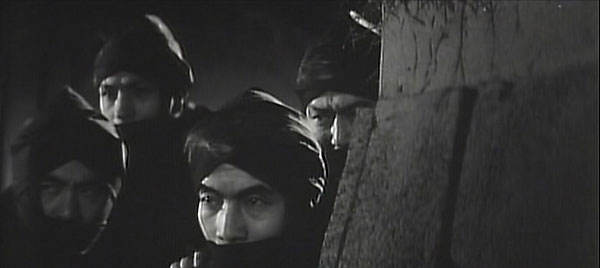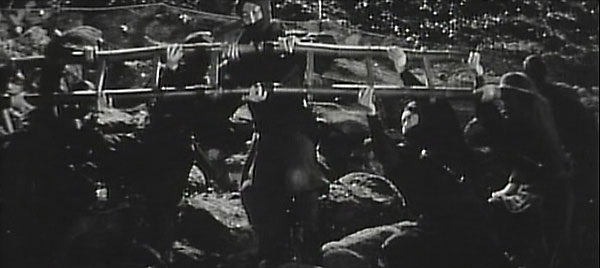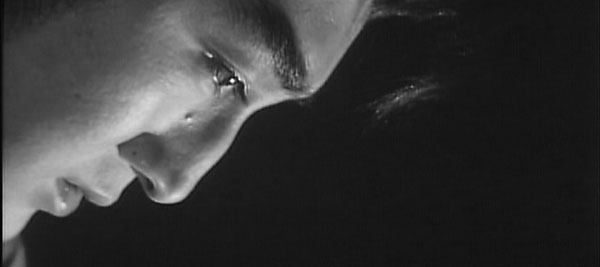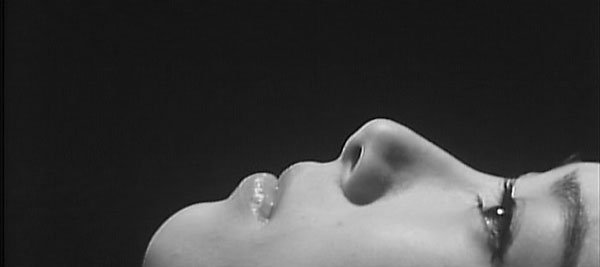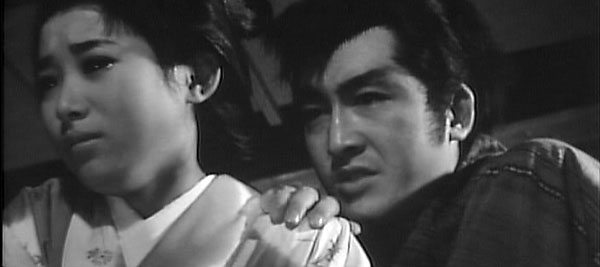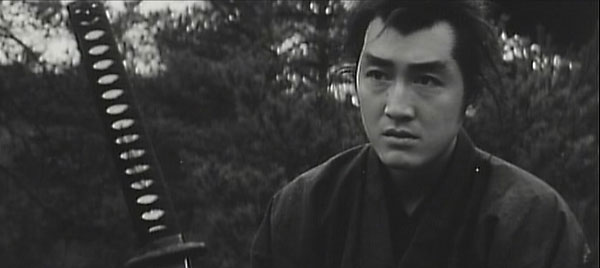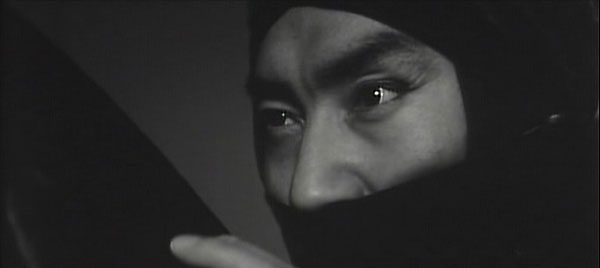SEVENTEEN NINJA (JUSHICHININ NO NINJA, 1963) is the typical 60’s Japanese boom film in that:
1.) It’s GREAT.
2.) It’s noir-as-hell — painted in gorgeous chiaroscuro cinematography.
3.) It’s also noir-as-hell because (from the gospel of James Ellroy) pretty much everybody in it is fucked. And…
4.) It does what the best shinobi cinema does, pits ninja-vs.-ninja in a world of samurai who would just assume see them all dead.
Again… and we never get sick of this… the intricacies of the ninja way of life and its weight on the soul of the individual are central to the motivations. Characters are either looking to escape the shadow life, or embrace the dark too readily. Duty is tantamount, but who that duty is to is a major source of disillusionment, and in the end, was it all worth it?
There are guys…
There are girls…
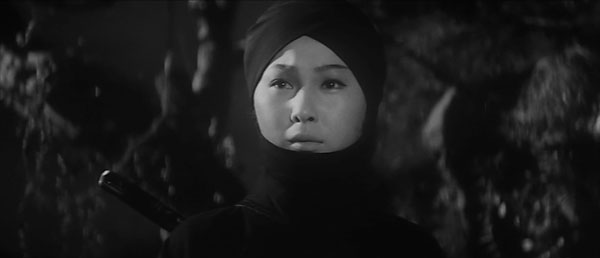
They’re not supposed to fall in love with each other but do. And actually being a human being for once, giving way to normal human emotions, is a cancer to the spartan shadow life the ninja clans needed their agents to live. The heart puts the team, the clan, and the mission in jeopardy.

In fine ‘born to lose’ form, that mission is essentially impossible, but at the same time impossible to turn down. A vital political document must be rescued from the corrupt clan that stole it. The document has no value to Iga, they’re fighting someone else’s battle here, doing the dirty work with the twisted pride these gloomy movies so often leaned on as a plot device — duty and obligation as a combination of doing what’s ‘right’ and being hired to do something no one thinks is possible but somehow you’ll figure out. It’s like a shadow-hubris in a way, so common to films of this era.
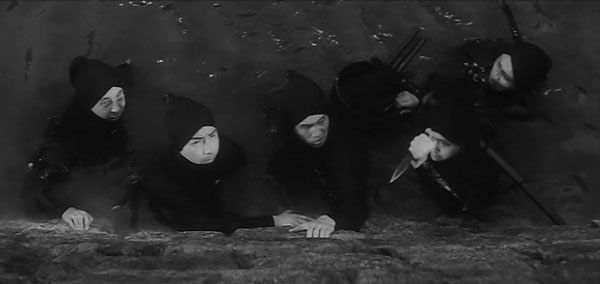
17N doubles that dynamic though. The conniving clan is fully aware the last of the Iga ninja have been assigned to retrieve the scroll, and have hidden the scroll in a ludicrously over-secure fortress occupied by a full garrison. Whereas the usual ninja commando tactics should work, Iga operatives keep getting caught and killed, one after another, due to the castle’s recently hired in-house anti-ninja specialist from rival Koga!
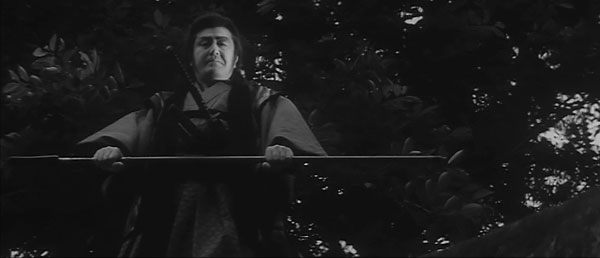
In the 1980s, the American ninja films may have taken the hoods out of the feudal era and put them in modern urban environs, but the ninja-vs.-ninja device remained at the genre’s core. Shadow skills taking down hapless guards and run-of-the-mill thugs was always fun second-act fare, but the third act needs your hero and villain to be equally matched for the conflict to actually matter.
Sho Kosugi’s famous “only a ninja can stop a ninja” notion is just as present in the 60s films that inspired him, although more in a larger-scale tactical way. One clan’s ninja are hired as an anti-ninja solution in the way an area overrun by cobras might let lose an imported population of mongoose. The opposing ninja are not only a military threat, they are selling out their own brethren’s way of life, and their’s too by default.
And in the end, everyone is expendable. The snakes may be gone, but who wants a plague of mongoose? The best of all solutions for the samurai clans involved is all of these vermin kill each other off.
17N is an all-star shinobi affair; Satomi Kotaro is the heroic young ninja stuck between a rock, a hard place and a harder place, while his clan leader played by Ryutaro Otomo suffers under the burden of command, especially when that role requires him to send his men to die. The shadow on the other side of the chess board is superbly rendered by Jushiro Konoe, no stranger to shinobi cinema as hunter (Ninja Gari) or prey (the Yagyu Secret Scrolls series).
Konoe’s ninja exterminator is as intelligent as he is ruthless, sniffing out planted agents and picking off spies with a yari spear like a mantis.
Great moment here as he senses an intruder, who is armed with a nifty telescoping yari of his own.
There are two emotional gears grinding against each other in this film. Otomo’s ninja leader positions his men like pawns, sacrificing 16 of them in an effort to put one in just the right spot for a surprise hit. It torments him to the point of self-sacrifice, he’s almost relieved at being captured and tortured, and clings to life only with the hope of seeing the gambit pay off.
Then there’s the Romeo & Juliet angle, which by the end of the 60s boom actually became a bit tired, but this early entry did it well. Having a romantic couple come out of this bloodbath intact, able to leave “the life” behind and live as loving real humans is the ultimate reward above and beyond the dispatching of duties.
The Romeo & Juliet angle begins the sequel film as well. SEVENTEEN NINJA 2: THE GREAT BATTLE (JUSHICHININ NO NINJA: DAIKESSEN, 1965 — aka Seventeen Ninja: Amunition and Ambition according to Paghat) sees Hiroki Matsukata take of the mantle of the reluctant man-of-Iga in love with a Koga kunoichi and burdened with an impossible mission.
Ryutaro Otomo returns in the heart-heavy Iga leader role (this time as Hattori Hanzo) once again facing a heavily guarded fortress and an anti-ninja specialist. Rival ninja Ginza is particularly vicious and driven, perhaps having bought too into the notion that winning here might elevate him out of the shadows. Hanzo, meanwhile, knows they’re both in the typical no-win situation.
The second film is a great watch, although lacking some of the subtleties of the first. It’s a more straightforward conflict — destroying a hidden arsenal of muskets that will tip the scales in a political revolt — much less of a soul-wringing chess game is played, although the black-hooded body count racks up the same.
By ’65 the Japanese ninja boom was approaching apex, shadow skills on display from every studio and on screens big and small. This film doesn’t provide as much exotic gadgetry and arcane skills as its predecessor (or other genre entries of the same time) but the action is still fine.
I love Matsukata in anything. He was the first ninja actor I was exposed to, via Magic Serpent being a staple of Boston UHF TV’s Creature Double Feature in the mid 70s. In that film, he lost his head to a gigantic ninja boomerang. Here, it’s over a gal. What’s a ninja gonna do?
The trick with these two very similar films is to not watch them back to back. Although the characters are different in name (and cast to a degree), the plot structure and dramatic devices are all the same, as are the bittersweet end results.
17N 2 was a rarity for the longest time, even in Japan. A video release last year finally put it in the hands of long-curious shinobi-cinemafiles who were FINALLY able to devour it. Beyond that initial excitement, the sequel is a solid ‘B’ to the first and more innovative film’s ‘A’ in my opinion. If you didn’t know of the existence of the 63 original though, the 65 film would be amongst your favorites, and it should be noted you absolutely do not need to be familiar with the first to enjoy the second.
Two movies, 34 ninja… what’s not to love?
READ MORE:
Another review of the first film at Shades of Grey.

